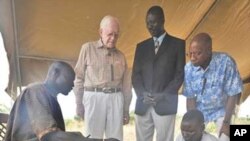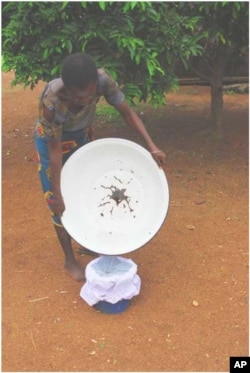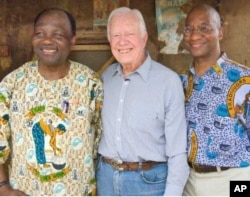“Sudan is the last stand for Guinea worm disease,” says former U.S. president Jimmy Carter. In the country’s southern region, almost 1400 people have the disease, says the Atlanta-based Carter Center.
Thirty-six cases remain in Ghana, Mali and Ethiopia.
Worldwide, the number of reported cases has been reduced from about 3.5 million in 1986 to about 3,200 now, according to the Center’s latest figures.
The region is largely underdeveloped and has little governmental or public health infrastructure.
“Southern Sudan has been affected for the last 25 years with a terrible war,” says Mr. Carter, “so in the midst of combat our volunteers are reluctant to go into some of the villages that are still involved in conflict, and that is a problem for us because some of those villages still have Guinea worm."
Uneasy ceasfire
“For a long time, almost all the war in Sudan was concentrated in the south. Now there is an uneasy ceasefire, and we have a very good working relationship with the president of the (semi-autonomous) South, Salva Kiir who requires his minister of health and others to cooperate with us.”
He says working under the Southern Sudan Ministry of Health is a corps of more than 13,500 health volunteers supported by 41 Sudanese and expatriate technical assistants from the Carter Center.”
“Ridding their nation of Guinea worm disease will show the world what Southern Sudan can do when they are not distracted by war,” says Mr. Carter.
“The fiery serpent,” as the disease has been called since ancient times, is spread through water infected with microscopic larvae. After they mature, the worms emerge from the body, causing great pain. The problem now becomes how to guarantee that it won’t return.
President Carter says the villagers can still drink water from the same pond as before -- as long as infected people don’t put their legs or other limbs into the water.
“It is a one year cycle; it has to go through a human being, and if nobody goes into the water for a year with an adult Guinea worm laying eggs, then the disease is gone from that pond forever,” explains Mr. Carter.
Lessons learned
The former U.S. president says the approach used in Nigeria is also being applied in other countries.
“We got as much publicity as possible for the remote areas and recruited as much assistance as we could in Nigeria,” he says. “Often the people in the villages are illiterate. Because of that, we had to use posters without words to illustrate the story of the Guinea worm. This kind of approach was very successful in Nigeria, where we started out with about 650 thousand cases and went down to zero.”
The Carter Center had another important tool in its arsenal: former African leaders. “The foremost leader that helped us has been Nigeria’s former president Yakubu Gowan, who happens to have a special interest in the disease,” Mr. Carter explains.
The others are the incumbent president of Mali, Ahmadou Toure, as well as the former president of Ghana, Flight Lieutenant Jerry Rawlings. “When Jerry Rawlings was in office,” says Mr. Carter, “he took it upon himself to educate English-speaking African countries about the disease.”
The witchcraft connection
The Carter Center is credited with respecting indigenous beliefs while eradicating the water-born parasite. The organization had to work around some of the beliefs, including erroneous ones, such as the idea that Guinea worm is caused by witchcraft.
“They claim the disease is not caused by Guinea worm eggs in the water but by other means, such as the curse of God, the confluence of the planets or drinking goat’s blood.”
One of the reasons for the misinformation was economic.
“Some of the religious leaders,” he says, “were making money treating the disease, and they did not want to give up their lucrative business…. We had to recruit these religious leaders to be partners with us instead of opponents of our program.”
Because of the Carter Center’s efforts to promote good health and democracy in the developing world, Guinea worm is the only disease besides smallpox that is close to being eradicated from the world.
The Carter Center has used the lessons from the successful campaign against Guinea worm to combat other diseases in Africa, including polio, schistosomiasis, onchocerciasis. (river blindness), trachoma, elephantiasis and malaria.
“In all those cases we used the same technique that we did with Guinea worm,” says President Carter.













